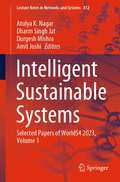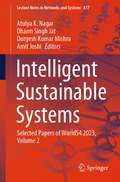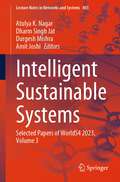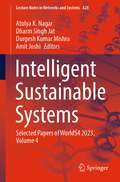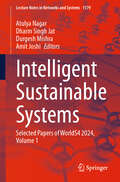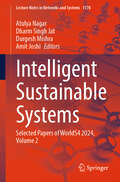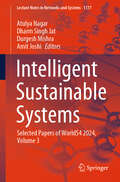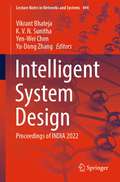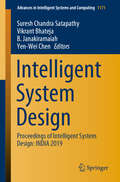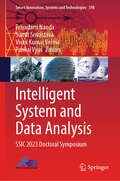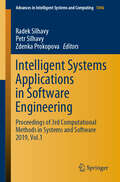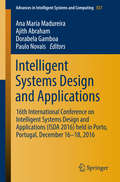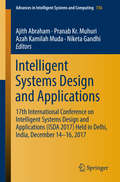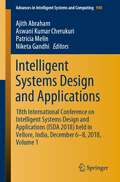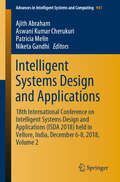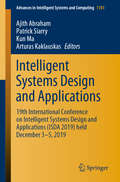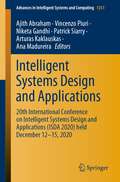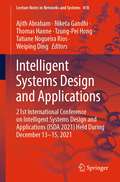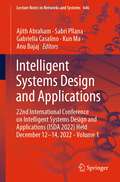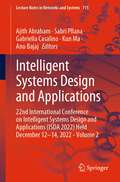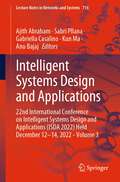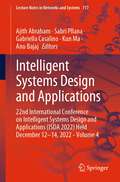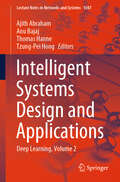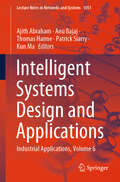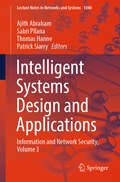- Table View
- List View
Intelligent Sustainable Systems: Selected Papers of WorldS4 2023, Volume 1 (Lecture Notes in Networks and Systems #812)
by Amit Joshi Atulya K. Nagar Dharm Singh Jat Durgesh MishraThis book provides insights of World Conference on Smart Trends in Systems, Security and Sustainability (WS4 2023) which is divided into different sections such as Smart IT Infrastructure for Sustainable Society; Smart Management Prospective for Sustainable Society; Smart Secure Systems for Next Generation Technologies; Smart Trends for Computational Graphics and Image Modeling; and Smart Trends for Biomedical and Health Informatics. The proceedings is presented in four volumes. The book is helpful for active researchers and practitioners in the field.
Intelligent Sustainable Systems: Selected Papers of WorldS4 2023, Volume 2 (Lecture Notes in Networks and Systems #817)
by Amit Joshi Durgesh Kumar Mishra Atulya K. Nagar Dharm Singh JatThis book provides insights of World Conference on Smart Trends in Systems, Security and Sustainability (WS4 2023) which is divided into different sections such as Smart IT Infrastructure for Sustainable Society; Smart Management Prospective for Sustainable Society; Smart Secure Systems for Next Generation Technologies; Smart Trends for Computational Graphics and Image Modeling; and Smart Trends for Biomedical and Health Informatics. The proceedings is presented in two volumes. The book is helpful for active researchers and practitioners in the field.
Intelligent Sustainable Systems: Selected Papers of WorldS4 2023, Volume 3 (Lecture Notes in Networks and Systems #803)
by Amit Joshi Atulya K. Nagar Dharm Singh Jat Durgesh MishraThis book provides insights of World Conference on Smart Trends in Systems, Security, and Sustainability (WS4 2023) which is divided into different sections such as Smart IT Infrastructure for Sustainable Society; Smart Management Prospective for Sustainable Society; Smart Secure Systems for Next Generation Technologies; Smart Trends for Computational Graphics and Image Modeling; and Smart Trends for Biomedical and Health Informatics. The proceedings is presented in two volumes. The book is helpful for active researchers and practitioners in the field.
Intelligent Sustainable Systems: Selected Papers of WorldS4 2023, Volume 4 (Lecture Notes in Networks and Systems #828)
by Amit Joshi Durgesh Kumar Mishra Atulya K. Nagar Dharm Singh JatThis book provides insights of World Conference on Smart Trends in Systems, Security and Sustainability (WS4 2023) which is divided into different sections such as Smart IT Infrastructure for Sustainable Society; Smart Management Prospective for Sustainable Society; Smart Secure Systems for Next Generation Technologies; Smart Trends for Computational Graphics and Image Modeling; and Smart Trends for Biomedical and Health Informatics. The proceedings is presented in four volumes. The book is helpful for active researchers and practitioners in the field.
Intelligent Sustainable Systems: Selected Papers of WorldS4 2024, Volume 1 (Lecture Notes in Networks and Systems #1179)
by Atulya Nagar Amit Joshi Dharm Singh Jat Durgesh MishraThis book provides insights of World Conference on Smart Trends in Systems, Security and Sustainability (WS4 2024) which is divided into different sections such as Smart IT Infrastructure for Sustainable Society; Smart Management Prospective for Sustainable Society; Smart Secure Systems for Next Generation Technologies; Smart Trends for Computational Graphics and Image Modeling; and Smart Trends for Biomedical and Health Informatics. The proceedings is presented in four volumes. The book is helpful for active researchers and practitioners in the field.
Intelligent Sustainable Systems: Selected Papers of WorldS4 2024, Volume 2 (Lecture Notes in Networks and Systems #1178)
by Atulya Nagar Amit Joshi Dharm Singh Jat Durgesh MishraThis book provides insights of World Conference on Smart Trends in Systems, Security and Sustainability (WS4 2024) which is divided into different sections such as Smart IT Infrastructure for Sustainable Society; Smart Management Prospective for Sustainable Society; Smart Secure Systems for Next Generation Technologies; Smart Trends for Computational Graphics and Image Modeling; and Smart Trends for Biomedical and Health Informatics. The proceedings is presented in four volumes. The book is helpful for active researchers and practitioners in the field.
Intelligent Sustainable Systems: Selected Papers of WorldS4 2024, Volume 3 (Lecture Notes in Networks and Systems #1177)
by Atulya Nagar Amit Joshi Dharm Singh Jat Durgesh MishraThis book provides insights of World Conference on Smart Trends in Systems, Security and Sustainability (WS4 2024) which is divided into different sections such as Smart IT Infrastructure for Sustainable Society; Smart Management Prospective for Sustainable Society; Smart Secure Systems for Next Generation Technologies; Smart Trends for Computational Graphics and Image Modeling; and Smart Trends for Biomedical and Health Informatics. The proceedings is presented in four volumes. The book is helpful for active researchers and practitioners in the field.
Intelligent System Design: Proceedings of INDIA 2022 (Lecture Notes in Networks and Systems #494)
by Yen-Wei Chen Vikrant Bhateja Yu-Dong Zhang K. V. N. SunithaThis book presents a collection of high-quality, peer-reviewed research papers from the 7th International Conference on Information System Design and Intelligent Applications (India 2022), held at BVRIT Hyderabad College of Engineering for Women, Hyderabad, Telangana, India, from February 25 to 26, 2022. It covers a wide range of topics in computer science and information technology, including data mining and data warehousing, high-performance computing, parallel and distributed computing, computational intelligence, soft computing, big data, cloud computing, grid computing and cognitive computing.
Intelligent System Design: Proceedings of Intelligent System Design: INDIA 2019 (Advances in Intelligent Systems and Computing #1171)
by Yen-Wei Chen Suresh Chandra Satapathy Vikrant Bhateja B. JanakiramaiahThis book presents a collection of high-quality, peer-reviewed research papers from the 6th International Conference on Information System Design and Intelligent Applications (INDIA 2019), held at Lendi Institute of Engineering & Technology, India, from 1 to 2 November 2019. It covers a wide range of topics in computer science and information technology, including data mining and data warehousing, high-performance computing, parallel and distributed computing, computational intelligence, soft computing, big data, cloud computing, grid computing and cognitive computing.
Intelligent System and Data Analysis: SSIC 2023 Doctoral Symposium (Smart Innovation, Systems and Technologies #398)
by Sumit Srivastava Vivek Kumar Verma Priyadarsi Nanda Pankaj VyasThis book features original papers from the Doctoral Symposium in 4th International Conference on Smart IoT Systems: Innovations and Computing (SSIC 2023), organized by Manipal University, Jaipur, India, during 26–27 October 2023. It discusses scientific works related to data engineering in the context of computational collective intelligence consisted of interaction between smart devices for smart environments and interactions. The book offers high-quality content and the broad range of topics useful for researchers pursuing advanced studies.
Intelligent Systems Applications in Software Engineering: Proceedings of 3rd Computational Methods in Systems and Software 2019, Vol. 1 (Advances in Intelligent Systems and Computing #1046)
by Radek Silhavy Petr Silhavy Zdenka ProkopovaThis book presents real-world problems and exploratory research that describes novel approaches in software engineering, cybernetics and algorithms in the context of intelligent systems. It constitutes the refereed proceedings of the 3rd Computational Methods in Systems and Software 2019 (CoMeSySo 2019) conference, a groundbreaking online conference that provides an international forum for discussing the latest high-quality research results.
Intelligent Systems Design and Applications
by Ajith Abraham Paulo Novais Ana Maria Madureira Dorabela GamboaThe proceedings of the Third International Conference on Intelligent Systems Design and Applications (ISDA 2003) held in Tulsa, USA, August 10-13. Current research in all areas of computational intelligence is presented including design of artificial neural networks, fuzzy systems, evolutionary algorithms, hybrid computing systems, intelligent agents, and their applications in science, technology, business and commerce. Main themes addressed by the conference are the architectures of intelligent systems, image, speech and signal processing, internet modeling, data mining, business and management applications, control and automation, software agents and knowledge management.
Intelligent Systems Design and Applications: 16th International Conference On Intelligent Systems Design And Applications (isda 2016) Held In Porto, Portugal, December 16-18 2016 (Advances in Intelligent Systems and Computing #23)
by Ajith Abraham Azah Kamilah Muda Niketa Gandhi Pranab Kr. MuhuriThis book highlights recent research on intelligent systems design and applications. It presents 100 selected papers from the 17th International Conference on Intelligent Systems Design and Applications (ISDA 2017), which was held in Delhi, India from December 14 to 16, 2017. The ISDA is a premier conference in the field of Computational Intelligence and brings together researchers, engineers and practitioners whose work involves intelligent systems and their applications in industry and the real world. Including contributions by authors from over 30 countries, the book offers a valuable reference guide for all researchers, students and practitioners in the fields of Computer Science and Engineering.
Intelligent Systems Design and Applications: 18th International Conference on Intelligent Systems Design and Applications (ISDA 2018) held in Vellore, India, December 6-8, 2018, Volume 1 (Advances in Intelligent Systems and Computing #940)
by Ajith Abraham Patricia Melin Aswani Kumar Cherukuri Niketa GandhiThis book highlights recent research on Intelligent Systems and Nature Inspired Computing. It presents 212 selected papers from the 18th International Conference on Intelligent Systems Design and Applications (ISDA 2018) and the 10th World Congress on Nature and Biologically Inspired Computing (NaBIC), which was held at VIT University, India. ISDA-NaBIC 2018 was a premier conference in the field of Computational Intelligence and brought together researchers, engineers and practitioners whose work involved intelligent systems and their applications in industry and the “real world.” Including contributions by authors from over 40 countries, the book offers a valuable reference guide for all researchers, students and practitioners in the fields of Computer Science and Engineering.
Intelligent Systems Design and Applications: 18th International Conference on Intelligent Systems Design and Applications (ISDA 2018) held in Vellore, India, December 6-8, 2018, Volume 2 (Advances in Intelligent Systems and Computing #941)
by Ajith Abraham Patricia Melin Aswani Kumar Cherukuri Niketa GandhiThis book highlights recent research on Intelligent Systems and Nature Inspired Computing. It presents 212 selected papers from the 18th International Conference on Intelligent Systems Design and Applications (ISDA 2018) and the 10th World Congress on Nature and Biologically Inspired Computing (NaBIC), which was held at VIT University, India. ISDA-NaBIC 2018 was a premier conference in the field of Computational Intelligence and brought together researchers, engineers and practitioners whose work involved intelligent systems and their applications in industry and the “real world.” Including contributions by authors from over 40 countries, the book offers a valuable reference guide for all researchers, students and practitioners in the fields of Computer Science and Engineering.
Intelligent Systems Design and Applications: 19th International Conference on Intelligent Systems Design and Applications (ISDA 2019) held December 3-5, 2019 (Advances in Intelligent Systems and Computing #1181)
by Ajith Abraham Patrick Siarry Kun Ma Arturas KaklauskasThis book highlights recent research on intelligent systems and nature-inspired computing. It presents 62 selected papers from the 19th International Conference on Intelligent Systems Design and Applications (ISDA 2019), which was held online. The ISDA is a premier conference in the field of computational intelligence, and the latest installment brought together researchers, engineers and practitioners whose work involves intelligent systems and their applications in industry. Including contributions by authors from 33 countries, the book offers a valuable reference guide for all researchers, students and practitioners in the fields of Computer Science and Engineering.
Intelligent Systems Design and Applications: 20th International Conference on Intelligent Systems Design and Applications (ISDA 2020) held December 12-15, 2020 (Advances in Intelligent Systems and Computing #1351)
by Ajith Abraham Vincenzo Piuri Patrick Siarry Arturas Kaklauskas Ana Madureira Niketa GandhiThis book highlights recent research on intelligent systems and nature-inspired computing. It presents 130 selected papers from the 19th International Conference on Intelligent Systems Design and Applications (ISDA 2020), which was held online. The ISDA is a premier conference in the field of computational intelligence, and the latest installment brought together researchers, engineers and practitioners whose work involves intelligent systems and their applications in industry. Including contributions by authors from 40 countries, the book offers a valuable reference guide for all researchers, students and practitioners in the fields of Computer Science and Engineering.
Intelligent Systems Design and Applications: 21st International Conference on Intelligent Systems Design and Applications (ISDA 2021) Held During December 13–15, 2021 (Lecture Notes in Networks and Systems #418)
by Ajith Abraham Thomas Hanne Tzung-Pei Hong Niketa Gandhi Tatiane Nogueira Rios Weiping DingThis book highlights recent research on intelligent systems and nature-inspired computing. It presents 132 selected papers from the 21st International Conference on Intelligent Systems Design and Applications (ISDA 2021), which was held online. The ISDA is a premier conference in the field of computational intelligence, and the latest installment brought together researchers, engineers and practitioners whose work involves intelligent systems and their applications in industry. Including contributions by authors from 34 countries, the book offers a valuable reference guide for all researchers, students and practitioners in the fields of Computer Science and Engineering.
Intelligent Systems Design and Applications: 22nd International Conference on Intelligent Systems Design and Applications (ISDA 2022) Held December 12-14, 2022 - Volume 1 (Lecture Notes in Networks and Systems #646)
by Ajith Abraham Kun Ma Sabri Pllana Anu Bajaj Gabriella CasalinoThis book highlights recent research on intelligent systems and nature-inspired computing. It presents 223 selected papers from the 22nd International Conference on Intelligent Systems Design and Applications (ISDA 2022), which was held online. The ISDA is a premier conference in the field of computational intelligence, and the latest installment brought together researchers, engineers, and practitioners whose work involves intelligent systems and their applications in industry. Including contributions by authors from 65 countries, the book offers a valuable reference guide for all researchers, students, and practitioners in the fields of computer science and engineering.
Intelligent Systems Design and Applications: 22nd International Conference on Intelligent Systems Design and Applications (ISDA 2022) Held December 12-14, 2022 - Volume 2 (Lecture Notes in Networks and Systems #715)
by Ajith Abraham Kun Ma Sabri Pllana Anu Bajaj Gabriella CasalinoThis book highlights recent research on intelligent systems and nature-inspired computing. It presents 223 selected papers from the 22nd International Conference on Intelligent Systems Design and Applications (ISDA 2022), which was held online. The ISDA is a premier conference in the field of computational intelligence, and the latest installment brought together researchers, engineers, and practitioners whose work involves intelligent systems and their applications in industry. Including contributions by authors from 65 countries, the book offers a valuable reference guide for all researchers, students, and practitioners in the fields of computer science and engineering.
Intelligent Systems Design and Applications: 22nd International Conference on Intelligent Systems Design and Applications (ISDA 2022) Held December 12-14, 2022 - Volume 3 (Lecture Notes in Networks and Systems #716)
by Ajith Abraham Kun Ma Sabri Pllana Anu Bajaj Gabriella CasalinoThis book highlights recent research on intelligent systems and nature-inspired computing. It presents 223 selected papers from the 22nd International Conference on Intelligent Systems Design and Applications (ISDA 2022), which was held online. The ISDA is a premier conference in the field of computational intelligence, and the latest installment brought together researchers, engineers, and practitioners whose work involves intelligent systems and their applications in industry. Including contributions by authors from 65 countries, the book offers a valuable reference guide for all researchers, students, and practitioners in the fields of computer science and engineering.
Intelligent Systems Design and Applications: 22nd International Conference on Intelligent Systems Design and Applications (ISDA 2022) Held December 12-14, 2022 - Volume 4 (Lecture Notes in Networks and Systems #717)
by Ajith Abraham Kun Ma Sabri Pllana Anu Bajaj Gabriella CasalinoThis book highlights recent research on intelligent systems and nature-inspired computing. It presents 223 selected papers from the 22nd International Conference on Intelligent Systems Design and Applications (ISDA 2022), which was held online. The ISDA is a premier conference in the field of computational intelligence, and the latest installment brought together researchers, engineers, and practitioners whose work involves intelligent systems and their applications in industry. Including contributions by authors from 65 countries, the book offers a valuable reference guide for all researchers, students, and practitioners in the fields of computer science and engineering.
Intelligent Systems Design and Applications: Deep Learning, Volume 2 (Lecture Notes in Networks and Systems #1047)
by Ajith Abraham Thomas Hanne Tzung-Pei Hong Anu BajajThis book highlights recent research on intelligent systems and nature-inspired computing. It presents 47 selected papers focused on Deep Learning from the 23rd International Conference on Intelligent Systems Design and Applications (ISDA 2023), which was held in 5 different cities namely Olten, Switzerland; Porto, Portugal; Kaunas, Lithuania; Greater Noida, India; Kochi, India, and in online mode. The ISDA is a premier conference in the field of artificial intelligence, and the latest installment brought together researchers, engineers, and practitioners whose work involves intelligent systems and their applications in industry. ISDA 2023 had contributions by authors from 64 countries. This book offers a valuable reference guide for all scientists, academicians, researchers, students, and practitioners in the field of artificial intelligence and deep learning.
Intelligent Systems Design and Applications: Industrial Applications, Volume 6 (Lecture Notes in Networks and Systems #1051)
by Ajith Abraham Patrick Siarry Thomas Hanne Kun Ma Anu BajajThis book highlights recent research on intelligent systems and nature-inspired computing. It presents 47 selected papers focused on Industrial Applications from the 23rd International Conference on Intelligent Systems Design and Applications (ISDA 2023), which was held in 5 different cities namely Olten, Switzerland; Porto, Portugal; Kaunas, Lithuania; Greater Noida, India; Kochi, India, and in online mode. The ISDA is a premier conference in the field of artificial intelligence, and the latest installment brought together researchers, engineers, and practitioners whose work involves intelligent systems and their applications in industry. ISDA 2023 had contributions by authors from 64 countries. This book offers a valuable reference guide for all industrial specialists, scientists, academicians, researchers, students, and practitioners in the field of artificial intelligence and industrial applications.
Intelligent Systems Design and Applications: Information and Network Security, Volume 3 (Lecture Notes in Networks and Systems #1048)
by Ajith Abraham Patrick Siarry Thomas Hanne Sabri PllanaThis book highlights recent research on intelligent systems and nature-inspired computing. It presents 50 selected papers focused on Information and Network Security from the 23rd International Conference on Intelligent Systems Design and Applications (ISDA 2023), which was held in 5 different cities namely Olten, Switzerland; Porto, Portugal; Kaunas, Lithuania; Greater Noida, India; Kochi, India, and in online mode. The ISDA is a premier conference in the field of artificial intelligence, and the latest installment brought together researchers, engineers, and practitioners whose work involves intelligent systems and their applications in industry. ISDA 2023 had contributions by authors from 64 countries. This book offers a valuable reference guide for all network and security specialists, scientists, academicians, researchers, students, and practitioners in the field of artificial intelligence and information/network security.
